Is it still a temple if there’s no idol?
A silent shift is happening inside Indian homes — especially among the design-aware millennial and Gen Z households. Spirituality is taking a minimal, aesthetic, and often non-religious form, moving away from traditional puja rooms towards passive prayer corners.
These are not conventional mandirs. They are carefully curated emotional sanctuaries — with soft lighting, neutral tones, meditative symbols, and grounding elements that hint at the sacred without explicitly showing it.
🧘 What Is Passive Prayer Decor?
“Passive Prayer” is a design philosophy — not a ritual practice. It refers to decor elements and spaces that evoke calm, reflection, and quiet reverence without being overtly religious or dominated by iconography.
● It is rooted in mindfulness, not dogma.
● It invites presence, not performance.
● It favors natural, soothing materials over gold embellishments.
● It leans on symbolism over statues.
Unlike traditional pooja rooms filled with deities, incense, bells, and chants — passive prayer corners feel sacred without saying so out loud.
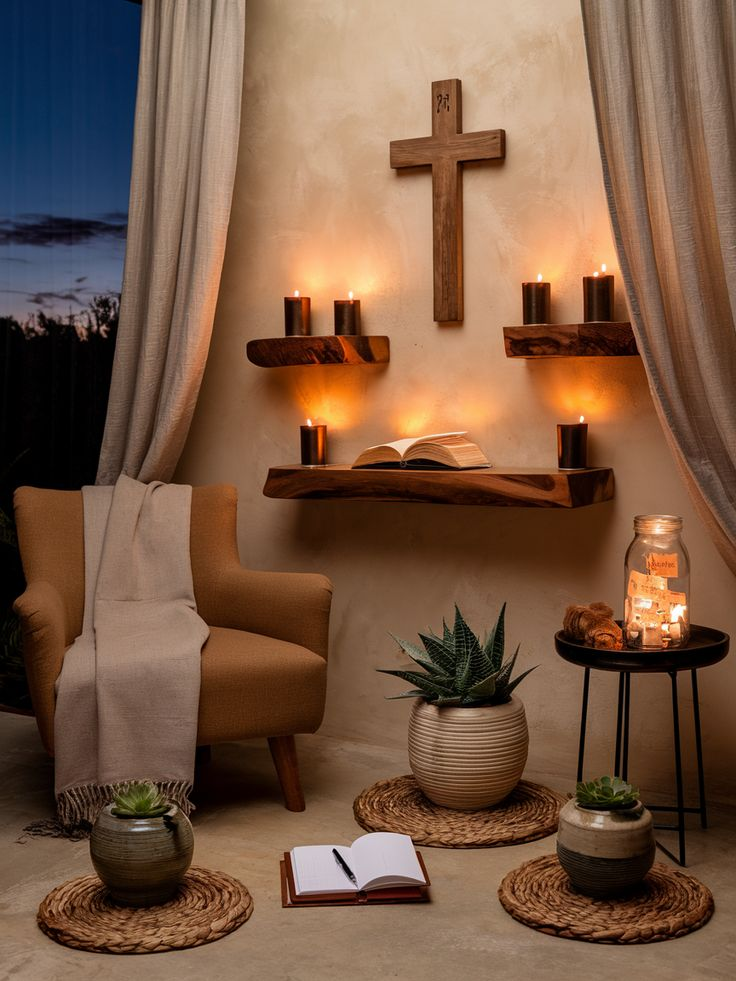
📖 Why This Shift Is Happening Now
Indian culture has always balanced form and feeling, but this current wave of passive spirituality is being driven by a complex mix of generational, emotional, and aesthetic reasons.
● Spiritual fluidity: Many younger Indians feel spiritual but not religious.
● Space constraints: Urban apartments rarely have room for full-fledged puja rooms.
● Design sensibility: Homeowners now demand visual subtlety and stylistic harmony.
● Mental wellness: Meditation, journaling, and healing practices have replaced daily rituals.
● Global influence: Japanese Zen, Scandinavian minimalism, and Wabi-Sabi aesthetics influence Indian interiors.
● Interfaith households: Mixed-religion or culturally fluid families opt for universal sacred design.
The result? Corners, nooks, and shelves across Indian homes are being transformed into intimate pockets of meaning — quiet, ambient, and emotionally grounding.
🪑 Common Features of Passive Prayer Corners
Though these spaces vary widely, certain recurring elements define their look and feel:
● Neutral palettes: Beiges, whites, taupes, or light wood tones dominate.
● Natural textures: Linen, rattan, clay, stone, terracotta, and wood.
● Ambient lighting: Hidden LEDs, salt lamps, candles, and lanterns.
● Symbolic objects: A single diya, a Bodhi leaf, Om sign, sacred geometry patterns, or Tibetan singing bowls.
● Floor seating: Cushions or low stools for meditation or journaling.
● Botanicals: Tulsi plants, bonsais, or dried eucalyptus.
● Minimal wall decor: Framed verses, calming abstract art, or handmade scrolls.
● Sound elements: Wind chimes, temple bells hung silently, or Bluetooth speakers for chants.
● Absence of clutter: Simplicity is the core spiritual tool.
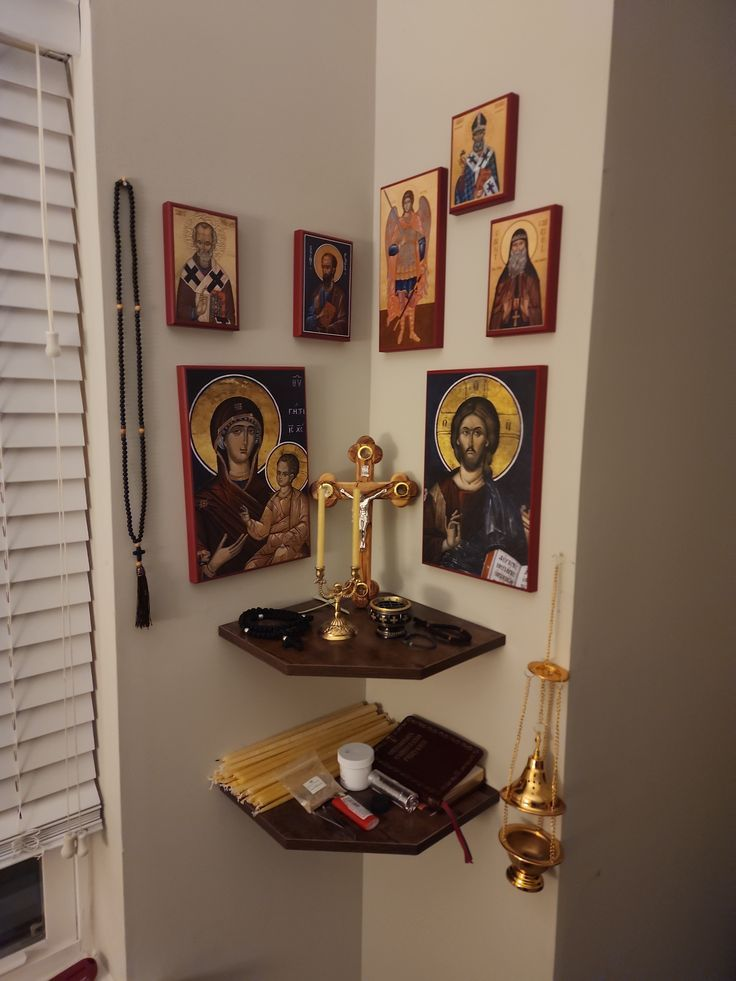
🛋️ Where They Are Located Inside Homes
Passive prayer zones aren’t hidden behind doors. They’re integrated subtly across living spaces:
● Living room niches: One corner softly lit, with a mat and incense.
● Bedroom edges: A cushion and diya setup for nightly silence.
● Balcony sanctuaries: With plants, bells, and birdsong.
● Study tables: Featuring spiritual texts or intention-setting corners.
● Foyer shelves: Displaying healing crystals or spiritual books.
● Wall niches: Carved for sacred symbols like the Tree of Life or lotus motifs.
The key is emotional intent — not the room’s function.
🌏 Influences from Around the World
This design approach draws deeply from non-Indian philosophies as well — blending sacredness across cultures:
● Japanese Zen: Emphasis on calm, light, space, and natural textures.
● Wabi-Sabi: The beauty of imperfection and transience — clay bowls, aged wood, etc.
● Scandinavian minimalism: Functional serenity with decluttered warmth.
● Buddhist design: Bell-shaped decor, Bodhi leaves, empty space.
● Islamic calligraphy: Verses rendered in abstract form, not figurative.
● Christian sacred corners: Cross motifs, candle-lit altars with plants.
● Indigenous Indian practices: Kolams, tribal patterns, and earthen finishes.
This allows a spiritually open household to design with heart — not hierarchy.
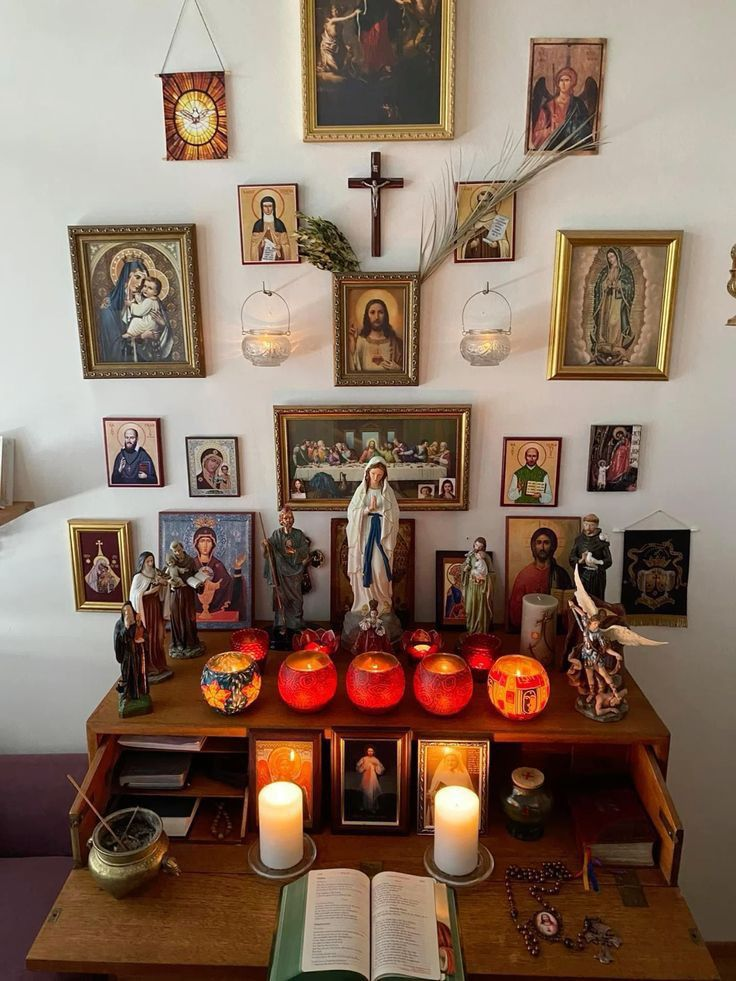
🧠 Emotional Psychology Behind Passive Spiritual Design
The biggest shift isn’t physical. It’s psychological.
Homeowners now seek decor that supports mental peace, emotional safety, and presence — not ritual correctness.
● These spaces support daily self-connection — morning intention-setting, meditation, journaling.
● They create soft stops in a fast home — places to pause, reflect, or just breathe.
● They act as personal sanctuaries during high-stress moments.
● They carry emotional continuity — a diya lit for someone, a bowl from a healing trip, a verse gifted by a parent.
● They don’t demand performance — they invite participation.
In a world of speed, this is slow spirituality — expressed through home design.
🪬 Passive vs Traditional Sacred Design: What’s the Difference?
| Design Element | Traditional Pooja Room | Passive Prayer Decor |
|---|---|---|
| Iconography | Idols, photos, framed gods | Abstract, symbolic, sometimes non-figurative |
| Ritual Use | Daily puja, aarti, offerings | Meditation, reflection, mindfulness |
| Materials | Marble, gold foil, tiles | Clay, linen, wood, cane |
| Color Palette | Bright, red, saffron, gold | Muted, natural, earthy |
| Cultural Framing | Religion-centric | Interfaith or spiritual but not religious |
| Emotional Tone | Reverence through worship | Reverence through silence and presence |
📦 Who Is Choosing Passive Prayer Decor?
This trend is not exclusive to elite or Westernized buyers. Across India, more people are intentionally designing emotionally sacred homes:
● Young working couples: Who want a spiritual space without religious rigidity.
● Gen Z homeowners: Who grew up watching parents perform rituals but now seek inner peace, not outer display.
● Interfaith families: Who want sacred harmony without leaning on one faith’s iconography.
● Mental health-conscious households: For whom a calming corner is more healing than tradition.
● Remote workers and digital nomads: Who need a grounding space within the home.
It’s not about rejecting religion — it’s about personalizing sacredness.
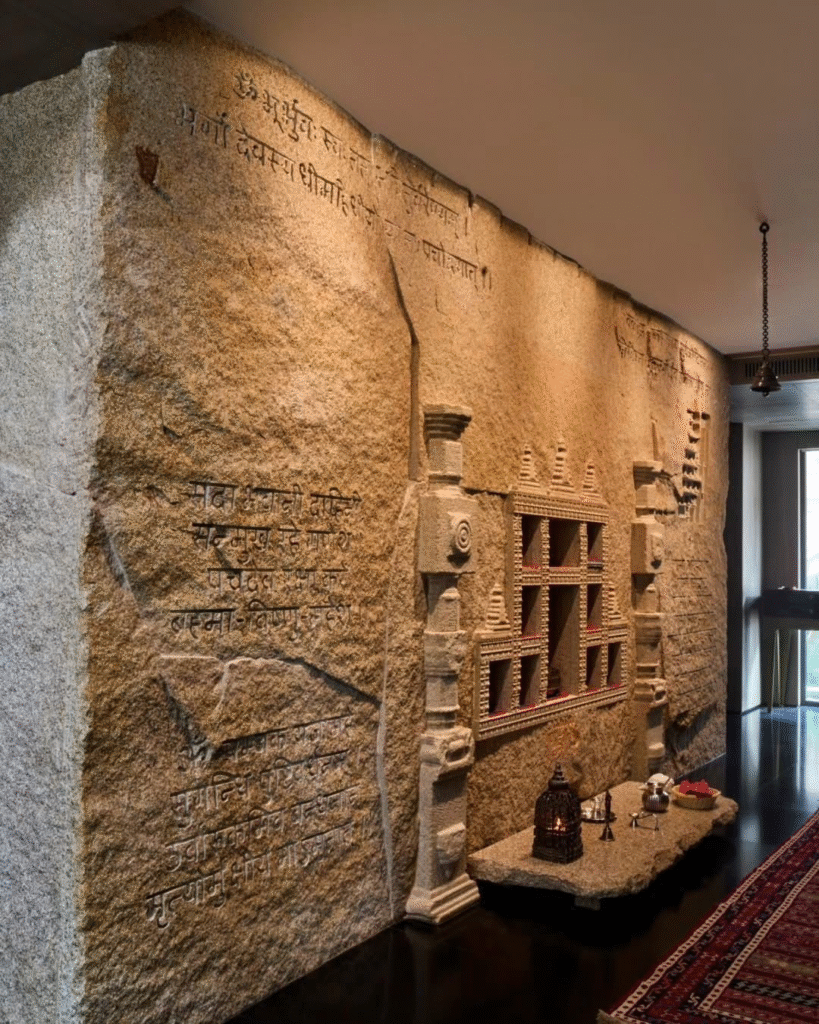
🪑 Product Ideas for a Passive Prayer Corner
Designers, home stylists, and even retailers can curate beautiful, non-religious spiritual decor with intent:
● Handmade clay diyas or oil lamps
● Rattan meditation stools or chatai rolls
● Framed quotes from Kabir, Rumi, or Upanishads
● Temple bell wind chimes
● Crystals, beads, and copper bowls
● Earthen urns for water or symbolic use
● Light linen curtains to diffuse morning light
● Wall-mounted wood shelves for sacred objects
● Singing bowls or incense trays with agarbattis
● Tulsi or bonsai planters in carved terracotta
The idea is emotive design over religious declaration.
🧩 Designer Tips: How to Create a Passive Prayer Corner
Here’s how interior designers can plan such spaces:
● Ask emotional questions, not religious ones. (“What calms you down?” > “Which god do you worship?”)
● Avoid direct iconography unless the client requests it.
● Use indirect symbolism — like tree motifs, spirals, or water bowls.
● Blend textures: wood + linen + clay works beautifully.
● Prioritize softness and silence — acoustics matter.
● Integrate with daylight, not artificial lighting alone.
● Allow for floor-level interaction — yoga, prayer, journaling.
● Keep it multi-use — reading, praying, or even resting.
● Avoid closed cabinets. Let energy flow.
Design for the spirit, not the script.
📱 The Rise of “Spiritual Decor” on Social Media
This trend is also visible in visual culture. On Pinterest and Instagram, hashtags like #SpiritualCorner, #ZenDecor, and #MindfulLiving have exploded.
● Influencers showcase altar shelves with plants, quotes, and candles.
● Decor reels feature minimalist home mandirs with matte finishes.
● Brands now offer non-religious sacred kits — combining incense, mood lights, and crystals.
● Platforms like Etsy, Jaypore, Nicobar, and The Wishing Chair offer curated products.
● Even mass brands like IKEA now subtly push emotion-driven living through their displays.
This is not a fad. It’s the evolution of Indian sacred life.
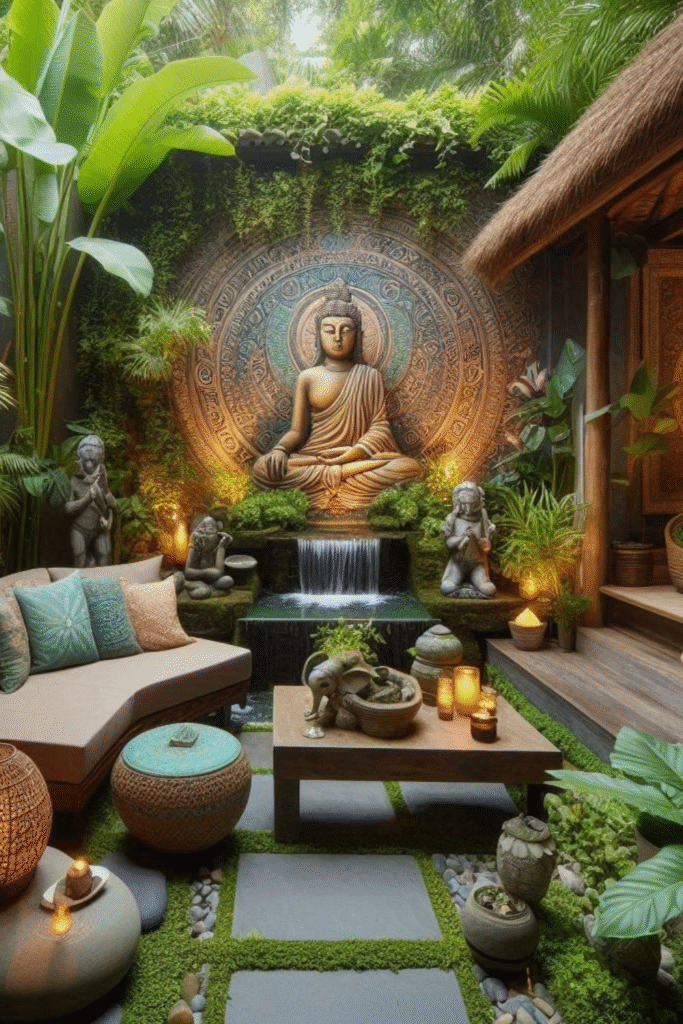
🌸 The Meaning of Sacred Is Expanding
At the heart of passive prayer decor is a powerful belief:
You don’t need to be religious to feel sacredness.
● A diya in memory of someone you lost is spiritual.
● A wall with your favorite shlok or Urdu verse is sacred.
● A clay bowl filled with rice grains can ground you after work.
● A lotus motif on a woven cushion can remind you to rise daily.
Design has the power to carry our deepest emotions — even our soul practices.
📍Closing Thoughts: Designing Stillness in the Age of Noise
We’re not moving away from the divine.
We’re moving closer to it — in our own, quieter, deeply personal ways.
Passive Prayer Decor is not rebellion.
It’s reclamation — of stillness, memory, and everyday connection to the invisible.
In a loud world, this is how India is silently saying:
“My home is my temple. And my temple begins with a feeling, not a photo frame.”
🔗 Want to design a spiritual corner that reflects your soul?
Let’s build soulful homes that center silence, not just structure.
For emotion-first architectural and interior design:
📩 Contact: contact@mishulgupta.com
📍Serving Ambala, Haryana & beyond
🌐 www.mishulgupta.com
